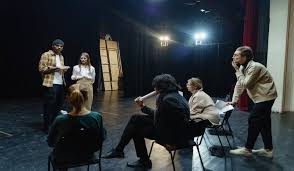Acting is each an artwork and a craft that calls for determination, practice, and a deep understanding of various techniques. Actors use special techniques to bring characters to lifestyles, creating performances that resonate with audiences. This article delves into the most influential performing strategies, providing insights into their origins, principles, and packages.
Stanislavski’s System: The Foundation of Acting Techniques
Stanislavski’s System is regularly taken into consideration the cornerstone of present day performing techniques. Developed by means of Russian actor and director Konstantin Stanislavski, this technique emphasizes the significance of naturalism and fact in overall performance. Stanislavski believed that actors should create plausible characters by way of drawing from their personal studies and emotions.
Emotional Memory
One key thing of Stanislavski’s System is emotional memory, where actors do not forget non-public experiences to evoke actual emotions on degree. This technique facilitates actors connect with their characters on a deeper stage, making their performances extra genuine.
The Magic If
Another precept is the “magic if,” which encourages actors to ask, “What if I have been in this situation?” This query enables actors immerse themselves in their roles by imagining how they might react of their man or woman’s situations.
Method Acting: Immersion and Transformation
Method acting, stimulated by means of Stanislavski’s standards, turned into similarly evolved through practitioners like Lee Strasberg, Stella Adler, and Sanford Meisner. This approach is known for its severe focus on person immersion and private enjoy.
Lee Strasberg’s Approach
Strasberg’s technique to technique performing emphasizes using affective reminiscence, in which actors draw on past feelings to tell their performances. This approach regularly calls for actors to delve deeply into their very own studies, which may be each effective and traumatic.
Stella Adler’s Technique
Stella Adler, any other prominent technique appearing trainer, diverged from Strasberg via encouraging actors to apply their creativeness as opposed to private reminiscences. Adler believed that depending solely on personal revel in should restriction an actor’s creativity. Her method entails enormous studies and the use of external stimuli to construct a person.
Sanford Meisner’s Technique
Sanford Meisner advanced a method that focuses on “residing honestly below imaginary circumstances.” His approach emphasizes spontaneity and reaction, schooling actors to reply instinctively to their scene companions. This method allows create dynamic and sensible interactions on degree and screen.
The Chekhov Technique: Psychological Gesture and Imagination
The Chekhov Technique, evolved via Russian actor Michael Chekhov, is understood for its emphasis on creativeness and bodily expression. Chekhov believed that actors ought to access their internal emotions through physical actions and gestures.
Psychological Gesture
A valuable element of the Chekhov Technique is the mental gesture. This involves growing a physical motion that encapsulates a character’s internal feelings and motivations. By embodying this gesture, actors can tap into their person’s emotional state, improving their overall performance.
Imagination and Atmosphere
Chekhov additionally stressed the importance of imagination and ecosystem. He encouraged actors to create vivid mental photographs in their man or woman’s international and to use these pics to tell their actions and reactions. This approach allows actors fully inhabit their roles, making their performances more compelling.
Practical Aesthetics: The Actor’s Toolbox
Practical Aesthetics, co-advanced by means of playwright David Mamet and actor William H. Macy, is a trustworthy method that emphasizes the actor’s analytical competencies. This approach specializes in breaking down a script to understand the individual’s goals and movements.
Script Analysis
Practical Aesthetics involves a rigorous technique to script analysis. Actors become aware of their person’s wishes, the limitations they face, and the procedures they use to acquire their desires. This evaluation helps actors make clean and precise alternatives, leading to greater focused and functional performances.
As-If Technique
Another key aspect is the “as-if” technique, wherein actors relate their person’s scenario to a comparable, but simpler, actual-lifestyles situation. This approach facilitates actors locate relatable, personal connections to their roles, making their performances extra believable and level-headed.
The Meisner Technique: Repetition and Reaction
The Meisner Technique, developed via Sanford Meisner, is focused around the idea of “living truthfully under imaginary instances.” This technique trains actors to cognizance on their scene companions and to react spontaneously to what’s going on within the moment.
Repetition Exercise
A hallmark of the Meisner Technique is the repetition workout. In this exercising, two actors repeat a simple phrase back and forth, focusing at the underlying emotions and reactions. This practice enables actors broaden a heightened feel of attention and responsiveness, growing greater proper interactions.
Emotional Preparation
Emotional instruction is any other vital issue of the Meisner Technique. Actors spend time earlier than a scene getting into the right emotional kingdom, making sure that their reactions are proper and spontaneous. This preparation allows actors live connected to their characters and the unfolding drama.
final result
Mastering distinct acting strategies is critical for any actor seeking to create memorable and actual performances. Each method gives precise tools and views, permitting actors to discover their craft and broaden their very own style. Whether it’s Stanislavski’s emphasis on reality, the immersive nature of technique appearing, the inventive technique of the Chekhov Technique, the analytical recognition of Practical Aesthetics, or the spontaneous reactions fostered by means of the Meisner Technique, every method contributes to the rich tapestry of acting. By studying and incorporating those techniques, actors can deepen their knowledge of their craft and produce their characters to existence in powerful and compelling approaches.
